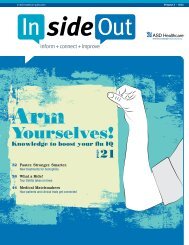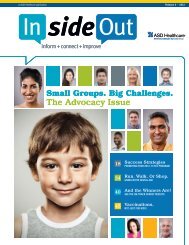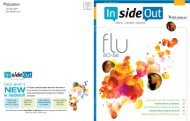media - ASD Healthcare
media - ASD Healthcare
media - ASD Healthcare
You also want an ePaper? Increase the reach of your titles
YUMPU automatically turns print PDFs into web optimized ePapers that Google loves.
AFLURIA ® (Influenza Virus Vaccine)BRIEF SUMMARY (For full Prescribing Information, see Package Insert)INDICATIONS AND USAGEAFLURIA is an inactivated influenza virus vaccine indicated for active immunization against influenza disease causedby influenza virus subtypes A and type B present in the vaccine. AFLURIA is approved for use in persons 5 years of ageand older.DOSAGE AND ADMINISTRATIONFor intramuscular (IM) injection only (0.5 mL).Dose and ScheduleChildrenChildren 5 years through 8 years of age not previously vaccinated with an influenza vaccine, or vaccinated for the firsttime last season with only one dose: Administer two 0.5 mL doses, one on Day 1 and another approximately 4 weeks later.Children 5 years through 8 years of age given two doses last season, or at least one dose two or more years ago:Administer a single 0.5 mL dose.Children 9 years of age and older: Administer a single 0.5 mL dose.AdultsAdminister a single 0.5 mL dose.AdministrationThe preferred site for intramuscular injection is the deltoid muscle of the upper arm.CONTRAINDICATIONSAFLURIA is contraindicated in individuals with known severe allergic reactions (e.g., anaphylaxis), to any component ofthe vaccine including egg protein, or to a previous dose of any influenza vaccine (see Description [11]).WARNINGS AND PRECAUTIONSFever and Febrile SeizuresAdministration of CSL’s 2010 Southern Hemisphere influenza vaccine was associated with postmarketing reports ofincreased rates of fever and febrile seizures in children predominantly below the age of 5 years as compared to previousyears; these increased rates were confirmed by postmarketing studies. Febrile events were also observed in children 5to less than 9 years of age.Guillain-Barré Syndrome (GBS)Guillain-Barré Syndrome (GBS) has occurred following vaccination with AFLURIA. If GBS has occurred within 6 weeks ofprevious influenza vaccination, the decision to give AFLURIA should be based on careful consideration of the potentialbenefits and risks.Preventing and Managing Allergic ReactionsAppropriate medical treatment and supervision must be available to manage possible anaphylactic reactions followingadministration of the vaccine.Altered ImmunocompetenceIf AFLURIA is administered to immunocompromised persons, including those receiving immunosuppressive therapy, theimmune response may be diminished.Limitations of Vaccine EffectivenessVaccination with AFLURIA may not protect all individuals.ADVERSE REACTIONSIn children 5 through 17 years of age, the most common injection-site reactions observed in clinical studies with AFLURIAwere pain (≥60%), redness (≥20%) and swelling (≥10%). The most common systemic adverse events were headache,myalgia (≥20%), malaise and fever (≥10%).In adults 18 through 64 years of age, the most common injection-site adverse reactions observed in clinical studieswith AFLURIA were tenderness (≥60%) and pain (≥40%). The most common systemic adverse events observed wereheadache, malaise, and muscle aches (≥20%).In adults 65 years of age and older, the most common injection-site adverse reactions observed in clinical studies withAFLURIA were tenderness (≥30%) and pain (≥10%).Clinical Trials ExperienceBecause clinical studies are conducted under widely varying conditions, adverse reaction rates observed in the clinicalstudies of a vaccine cannot be directly compared to rates in the clinical studies of another vaccine and may not reflectthe rates observed in clinical practice.ChildrenIn clinical studies, AFLURIA has been administered to, and safety information collected for, 3,009 children ages 6 monthsto less than 18 years. Clinical safety data for AFLURIA in children is presented from three clinical studies (Studies 1, 2, and3). Data from a comparator-controlled trial (Study 1) are presented, followed by pooled data from two open label studies(Studies 2 and 3). Subjects 6 months through 8 years of age received one or two vaccinations as determined by previousvaccination history (for further details on clinical study design, dosing and demographics see Clinical Studies [14]).Study 1 included 1,468 subjects for safety analysis, ages 6 months to less than 18 years, randomized to receive AFLURIA(735 subjects) or another U.S.-licensed trivalent inactivated influenza vaccine (manufactured by Sanofi Pasteur, Inc.)(733 subjects).Study 2 included 1,976 subjects for safety analysis, ages 6 months to less than 18 years. All subjects received AFLURIA.Study 3 included 298 subjects for safety analysis, ages 6 months to less than 9 years. All subjects received AFLURIA.The safety assessment was similar for the three pediatric studies. Local (injection site) and systemic adverse eventswere solicited for 7 days post-vaccination (Tables 1 and 2 in the Prescribing Information). Unsolicited adverse eventswere collected for 30 days post-vaccination. All adverse events are presented regardless of any treatment causalityassigned by study investigators.Among the pediatric studies, there were no vaccine-related deaths or vaccine-related serious adverse events reportedin children 5 years of age and older.In the comparator-controlled trial (Study 1), the rate of fever after the first dose of AFLURIA in subjects aged 5 to lessthan 9 years was 16% as compared to 8% in subjects who received the comparator. The rate of fever in subjects aged9 to less than 18 years following a single dose of AFLURIA was 6% as compared to 4% in subjects who received thecomparator. In all three pediatric studies, the rates of fever in subjects aged 5 to less than 9 years who received AFLURIAwere lower after dose 2 than dose 1.The data below are presented for children 5 years and older.Proportion of Subjects 5 Through 17 Years of Age With Solicited Local or Systemic Adverse Events Within 7 DaysAfter First or Second Dose of AFLURIA, Irrespective of Causality (Study 1)The most common solicited adverse reactions (>20%) in Study 1 were pain, redness, myalgia, malaise, and headache(subjects aged 5 years to less than 9 years of age) and pain, myalgia, malaise, and headache (subjects aged 9 yearsto less than 18 years).Proportion of Subjects 5 Through 17 Years of Age With Unsolicited Adverse Events (Study 1)In Study 1, unsolicited adverse events that occurred in ≥5% of subjects who received AFLURIA in ages 5 years to lessthan 9 years following the first or second dose included cough (15%) and pyrexia (9%). Unsolicited adverse events thatoccurred in ≥5% of subjects who received AFLURIA in ages 9 years to less than 18 years following the first dose includedcough (7%), oropharyngeal pain (7%), headache (7%), and nasal congestion (6%).Proportion of Subjects 5 Through 17 Years of Age With Solicited Local or Systemic Adverse Events Within 7 DaysAfter Administration of AFLURIA, Irrespective of Causality (Studies 2 and 3)The most common solicited adverse reactions (>20%) in Studies 2 and 3 were pain and erythema (subjects aged 5 yearsto less than 9 years of age) and pain, headache, and general muscle ache (subjects aged 9 years to less than 18 years).Proportion of Subjects 5 Through 17 Years of Age With Unsolicited Adverse Events (Studies 2 and 3)In Studies 2 and 3, unsolicited adverse events that occurred in ≥5% of subjects ages 5 years to less than 9 years afterthe first or second dose included the following: upper respiratory tract infection (13%), cough (10%), rhinorrhea (7%),headache (5%), nasopharyngitis (5%) and pyrexia (5%). Unsolicited adverse events that occurred in ≥5% of subjectswho received AFLURIA in ages 9 years to less than 18 years following the first dose included upper respiratory tractinfection (9%) and headache (8%).AdultsIn clinical studies, a single dose of AFLURIA was administered to, and safety information collected for, 11,104subjects ages 18 to less than 65 years and 836 subjects ages 65 years and older. Clinical safety data for AFLURIAin adults are presented from three clinical studies (Studies 4 through 6). In all adult studies, there were novaccine-related deaths or vaccine-related serious adverse events reported.Study 4 included 1,357 subjects for safety analysis, ages 18 to less than 65 years, randomized to receive AFLURIA(1,089 subjects) or placebo (268 subjects) (see Clinical Studies [14]).Study 5 included 15,020 subjects for safety analysis, ages 18 to less than 65 years, randomized to receive AFLURIA(10,015 subjects) or placebo (5,005 subjects) (see Clinical Studies [14]).Study 6 included 1,266 subjects for safety analysis, ages 65 years and older, randomized to receive AFLURIA(630 subjects) or another U.S.-licensed trivalent inactivated influenza vaccine (manufactured by Sanofi PasteurSA) as an active control (636 subjects) (see Clinical Studies [14]).The safety assessment was identical for the three adult studies. Local (injection-site) and systemic adverseevents were solicited for 5 days post-vaccination (Table 3). Unsolicited adverse events were collected for 21days post-vaccination. All adverse events are presented regardless of any treatment causality assigned by studyinvestigators.Proportion of Subjects 18 Years of Age and Older With Solicited Local or Systemic Adverse Events Within 5Days After Administration of AFLURIA or Placebo, Irrespective of Causality (Studies 4, 5, and 6)In Studies 4, 5, and 6, the solicited local or systemic adverse events that occurred in ≥20% of subjects who receivedAFLURIA (regardless of causality) were as follows:Study 4: tenderness (pain on touching), pain without touching, headache, malaise.Study 5: tenderness (pain on touching), pain without touching, headache, malaise, muscle aches.Study 6: tenderness (pain on touching).Proportion of Adult Subjects With Unsolicited Adverse Events (Studies 4, 5, and 6)In Study 4, headache was the only unsolicited adverse event that occurred in ≥5% of subjects who received AFLURIAor placebo (8% versus 6%, respectively).In Study 5, headache was the only unsolicited adverse event that occurred in ≥5% of subjects who received AFLURIAor placebo (12% versus 11%, respectively).In Study 6, unsolicited adverse events that occurred in ≥5% of subjects who received AFLURIA included headache(8%), nasal congestion (7%), cough (5%), rhinorrhea (5%), and pharyngolaryngeal pain (5%).Postmarketing ExperienceBecause postmarketing reporting of adverse reactions is voluntary and from a population of uncertain size, it is notalways possible to reliably estimate their frequency or establish a causal relationship to vaccine exposure. The adversereactions described have been included in this section because they: 1) represent reactions that are known to occurfollowing immunizations generally or influenza immunizations specifically; 2) are potentially serious; or 3) have beenreported frequently. These adverse reactions reflect experience in both children and adults and include those identifiedduring post-approval use of AFLURIA outside the US since 1985.Blood and lymphatic system disordersTransient thrombocytopeniaImmune system disordersAllergic reactions including anaphylactic shock and serum sicknessNervous system disordersNeuralgia, paresthesia, and convulsions (including febrile seizures); encephalopathy, neuritis or neuropathy, transversemyelitis, and GBSVascular disordersVasculitis with transient renal involvementSkin and subcutaneous tissue disordersPruritus, urticaria, and rashAdverse Reactions Associated With Influenza VaccinationAnaphylaxis has been reported after administration of AFLURIA. Egg protein can induce im<strong>media</strong>te hypersensitivityreactions among persons who have severe egg allergy. Allergic reactions include hives, angioedema, asthma, andsystemic anaphylaxis (see Contraindications [4]).The 1976 swine influenza vaccine was associated with an increased frequency of GBS. Evidence for a causal relation ofGBS with subsequent vaccines prepared from other influenza viruses is unclear. If influenza vaccine does pose a risk, itis probably slightly more than one additional case per 1 million persons vaccinated.Neurological disorders temporally associated with influenza vaccination, such as encephalopathy, optic neuritis/neuropathy, partial facial paralysis, and brachial plexus neuropathy, have been reported.Microscopic polyangiitis (vasculitis) has been reported temporally associated with influenza vaccination.DRUG INTERACTIONSConcurrent Use With Other VaccinesThere are no data to assess the concomitant administration of AFLURIA with other vaccines. If AFLURIA is to be givenat the same time as another injectable vaccine(s), the vaccine(s) should be administered at different injection sites.AFLURIA should not be mixed with any other vaccine in the same syringe or vial.Concurrent Use With Immunosuppressive TherapiesThe immunological response to AFLURIA may be diminished in individuals receiving corticosteroid or immunosuppressivetherapies.USE IN SPECIFIC POPULATIONSPregnancyPregnancy Category B: A reproductive and developmental toxicity study has been performed in female rats at a doseapproximately 265 times the human dose (on a mg/kg basis) and revealed no evidence of impaired female fertility orharm to the fetus due to AFLURIA. There are, however, no adequate and well-controlled studies in pregnant women.Because animal reproduction studies are not always predictive of human response, AFLURIA should be given to apregnant woman only if clearly needed.In the reproductive and developmental toxicity study, the effect of AFLURIA on embryo-fetal and pre-weaningdevelopment was evaluated in pregnant rats. Animals were administered AFLURIA by intramuscular injection twiceprior to gestation, once during the period of organogenesis (gestation day 6), and once later in pregnancy (gestationday 20), 0.5 mL/rat/occasion (approximately a 265-fold excess relative to the projected human dose on a body weightbasis). No adverse effects on mating, female fertility, pregnancy, parturition, lactation parameters, and embryo-fetalor pre-weaning development were observed. There were no vaccine-related fetal malformations or other evidence ofteratogenesis.Nursing MothersAFLURIA has not been evaluated in nursing mothers. It is not known whether AFLURIA is excreted in human milk. Becausemany drugs are excreted in human milk, caution should be exercised when AFLURIA is administered to a nursing woman.Pediatric UseAFLURIA is not approved for use in children less than 5 years of age. In a clinical study in which children received AFLURIAor a US-licensed comparator vaccine (Study 1, see Clinical Trials Experience, [6.1]), the incidence of fever in children 6months to less than 3 years of age following the first and second doses of AFLURIA were 37% and 15%, respectively,as compared to 14% following each dose in the comparator group. Among children 3 years to less than 5 years of age,the incidence of fever following the first and second doses of AFLURIA were 32% and 14%, respectively, as comparedto 11% and 16% in the comparator. In an open-label study (Study 2), fever, irritability, loss of appetite, and vomiting/diarrhea occurred more frequently in children 6 months to less than 3 years of age as compared to older children. Acrossthree pediatric studies of AFLURIA (Studies 1, 2, and 3), 1.2% of eligible children (n=1,764) were discontinued from thesecond vaccination because of severe fever (≥104°F) within 48 hours of the first vaccination. Across the three pediatricstudies, two children, a 7-month old and a 3-year old, experienced vaccine-related febrile seizures (rate of 0.07% acrossstudies), one of which was serious.Administration of CSL’s 2010 Southern Hemisphere influenza vaccine was associated with increased rates of fever andfebrile seizures, predominantly in children below the age of 5 years as compared to previous years, in postmarketingreports confirmed by postmarketing studies (see Warnings and Precautions [5.1]).Geriatric UseIn clinical studies, AFLURIA has been administered to, and safety information collected for, 836 subjects ages 65 yearsand older (see Clinical Trials Experience [6.1]). After administration of AFLURIA, hemagglutination-inhibiting antibodyresponses in persons 65 years of age and older were lower as compared to younger adult subjects (see Clinical Studies [14]).HOW SUPPLIED/STORAGE AND HANDLINGPresentation: Carton NDC Number ComponentsPre-Filled Syringe 33332-012-01 Ten 0.5 mL single-dose syringes without needles [NDC 33332-012-02]Multi-Dose Vial 33332-112-10 One 5 mL vial, which contains ten 0.5 mL doses [NDC 33332-112-11]Store refrigerated at 2–8°C (36–46°F). Do not freeze. Discard if product has been frozen. Protect from light. Do not useAFLURIA beyond the expiration date printed on the label. Once the stopper of the multi-dose vial has been pierced, thevial must be discarded within 28 days.Manufactured by: CSL Limited, Parkville, Victoria, 3052, Australia, US License No. 1764Distributed by: Merck Sharp & Dohme Corp., a subsidiary of MERCK & CO., INC., Whitehouse Station, NJ 08889, USAAFLURIA is a registered trademark of CSL Limited. CSL Biotherapies is a division of CSL Limited.Copyright © 2012 Merck Sharp & Dohme Corp., a subsidiary of Merck & Co., Inc. All rights reserved.Updated as of 10/1222 InsideOut






